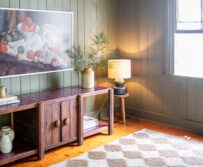All about the money honey!
Is there anything sexier than talking about renovation budgets… I think not! But it’s a necessary evil. When you renovate, unless you have bottomless pockets, there is always going to be a tug of war between what you want and what you can afford – welcome to the world of renos! With the help of Ben I worked that out within the first half hour. When you’re planning what to do, the process is characterised by adding up the cost of what you want to do and then having to remove items from your scope. In that way, this process is bit of a feedback loop where you go back and forth until you get to the right amount of work for a price you can live with. In case you’re just about to embark on this journey, we put together a bit of a flowchart to guide you through it.
How To Plan Your Renovation Budget
Where to Find Indicative Renovation Prices
Often when you start renovating you have, like, ZERO idea of what it ‘s going to cost. So it’s all good and well to say ‘work within your budget’, but if you have no idea what your budget can get you it can be a bit confusing. So, once you’ve decided what you can afford to spend, it’s time to work out what that will get you, even in just a broad sense. As I mentioned in the last post, it’s a great idea at this stage to get in touch with a builder and understand prices. However, before you do that, there are a few other places you can also find out about costs. The cost of a renovation is usually a combination of labour and materials, which differ everywhere in the world. So, the first thing to do is to track down some online guide for your country or city. From what I understand
- Australia: Realestate.com.au
- USA: Remodeling Calculator
- Europe: Construction Costs Calculator
In you live in other parts of the world, search for ‘renovation calculator + your city’. Try to find something official, and also know that it will only offer you a ballpark figure but it’s worth it if you want to get a headstart on chatting with a builder.
Our $$$ Experience
When you buy a house you commit to a big investment, one that is both terrifying (will I ever get out of this hole!?) and exciting (my money is finally going towards something good!). Like everyone who renovates, our first crack at the design was a bit of wishful thinking, a very design-led approach with major work required in the roofline and other (v v costly) things. Naturally, that came in way over the amount of renovating money we had, something that we expected but wanted to check anyway. Wah! Ben and his team then set to work designing something new and more simple that would suit our budget, and once we had finalised that scope we moved forward with that. Obviously part of this was making sure we were spending money on important items that would maximise the return (light, orientation, storage, space) and saving on things that wouldn’t give us such a great return (overly expensive fittings, details that people wouldn’t notice, pool etc). More on that soon!
Bespoke Style (On A Budget)
On a personal note, one of the interesting things that happened when Ben and I started designing the house, and I showed him all the inspiration I loved, was that he quickly pretty quickly let me know that all those gorgeous images on my Pinterest boards were created on biigggg budgets. It turns out that handmade tiles, custom cabinetry and incredible bespoke windows aren’t things of a tight budget. Knowing that our money is a little tighter than your average Hollywood Hills celebrity remodel, we knew straight away that the theme for this project would be all about how to create design and bespoke-inspired (note the INSPIRED) style on a budget. If you’ve been following me for a long time you’ll know that the love of an upcycled bargain is in my DNA, so I feel totally up to this challenge. Luckily Ben deals with this sort of thing all time, balancing his client’s budget with what they envision a space to be, and he’s already shared some amazing professional inspired hacks that take a simple, off the rack piece into something bespoke and designer inspired. I can’t wait to share with you all the ideas! Stay tuned for the plans and progress… So much has happened already.
Flow chart by Natalie Ong.



















